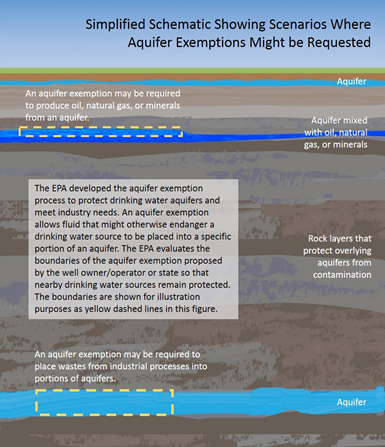Aquifer Exemptions in the Underground Injection Control Program
On this page:
- Information on aquifer exemptions
- Procedures, roles, and responsibilities
- Federal regulations and criteria for granting aquifer exemptions
- Aquifer exemption locations
- Frequently asked questions
Information on aquifer exemptions
An aquifer is an underground body of rock that contains or can transmit groundwater. The UIC regulations allow EPA to exempt aquifers that do not currently serve as a source of drinking water and will not serve as a source of drinking water in the future, based on certain criteria. Aquifer exemptions allow these underground sources of water to be used by energy, mining, and other companies for oil or mineral extraction or disposal purposes in compliance with EPA’s UIC requirements under the Safe Drinking Water Act.
The process begins when EPA receives information about the aquifer proposed for exemption from a state agency or well owner or operator. EPA approves the aquifer exemption request if it meets the necessary criteria, including a demonstration that fluids will not migrate outside of the exemption boundary. Injection of fluids can begin only after EPA approves an aquifer exemption and an underground injection control permit is granted.

Procedures, roles, and responsibilities
The EPA reviews the site information, the demonstration that the aquifer exemption meets the regulatory criteria, and comments from the public. The EPA approves the aquifer exemption request if it meets the necessary criteria. Injection of fluids begins only after the EPA approves an aquifer exemption and an underground injection control permit is granted.
All exemptions are subject to public input. The primacy state(s) or EPA must provide notice and opportunity for public hearing for aquifer exemptions. When the primacy state conducts public review of an aquifer exemption, the public comments are included in the EPA’s review.
Federal regulations and criteria for granting aquifer exemptions
Two federal UIC regulations address the:
- Identification of aquifer exemptions by states
- Evaluation and review of aquifer exemption requests by EPA
40 CFR 144.7:
- Allows the UIC program director to identify aquifers or portions of aquifers that are exempt from the definition of a USDW
- Prescribes procedural rules for EPA review and approval
- Describes delineation procedures for exempted aquifers or portions of aquifers.
40 CFR 146.4 provides the criteria that an applicant must meet for EPA to approve an aquifer exemption.
Aquifer exemption locations
EPA published an interactive map which allows users to view aquifers that have been approved for exemption by EPA under the Safe Drinking Water Act (SDWA) UIC regulations. EPA is also providing geospatial files and Excel data with an accompanying user guide. The map shows the approved aquifer exemption boundaries, when available, in two dimensions, and information such as the depth of injection, local geology, and injected fluid characteristics. The Excel spreadsheet provides descriptive information from the geospatial file without geospatial data. Users may download the datasets, fact sheet, and a user guide from the "Further Information" tab of the map.
The map and accompanying data can be used by states, businesses, communities, and others to view exempted aquifers in the United States, see accompanying aquifer exemption data like depth of injection, local geology, and injected fluid characteristics, and can assist with UIC permit applications and approvals. The map consolidates information that was previously only available on paper and/or in databases at the Regional and state level and will assist EPA and states in maintaining consistent exemption data across the nation.

Learn more about aquifer exemptions.
Frequently asked questions
What is an aquifer?
An aquifer is an underground body of rock that contains or can transmit groundwater.
What is the difference between an aquifer and an underground source of drinking water?
An aquifer is an underground body of rock that contains or can transmit groundwater. An underground source of drinking water is defined as an aquifer that supplies a public water system, or contains a sufficient quantity of groundwater to supply a public water system; and currently supplies drinking water for human consumption; or contains fewer than 10,000 mg/L total dissolved solids.
What is an aquifer exemption?
The UIC regulations allow EPA to exempt aquifers that do not currently serve as a source of drinking water and will not serve as a source of drinking water in the future, based on certain criteria. Aquifer exemptions allow these underground sources of water to be used by energy and mining companies for oil or mineral extraction or disposal purposes in compliance with EPA’s UIC requirements under SDWA.
What are the steps in the aquifer exemption decision process?
Usually, a state or operator identifies the area for exemption and submits the request to the EPA, demonstrating that the criteria for exemption have been met. The EPA reviews the aquifer exemption request and all the supporting documentation. The EPA may request clarifying information, if necessary, from the state or applicant. A decision document is developed by the EPA to document the decision to approve or deny the request. In most cases, the appropriate EPA Regional Administrator reviews the request and makes the final determination. In some cases, it may be the EPA Administrator who makes the final determination.
